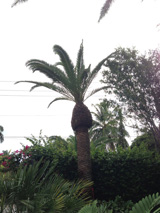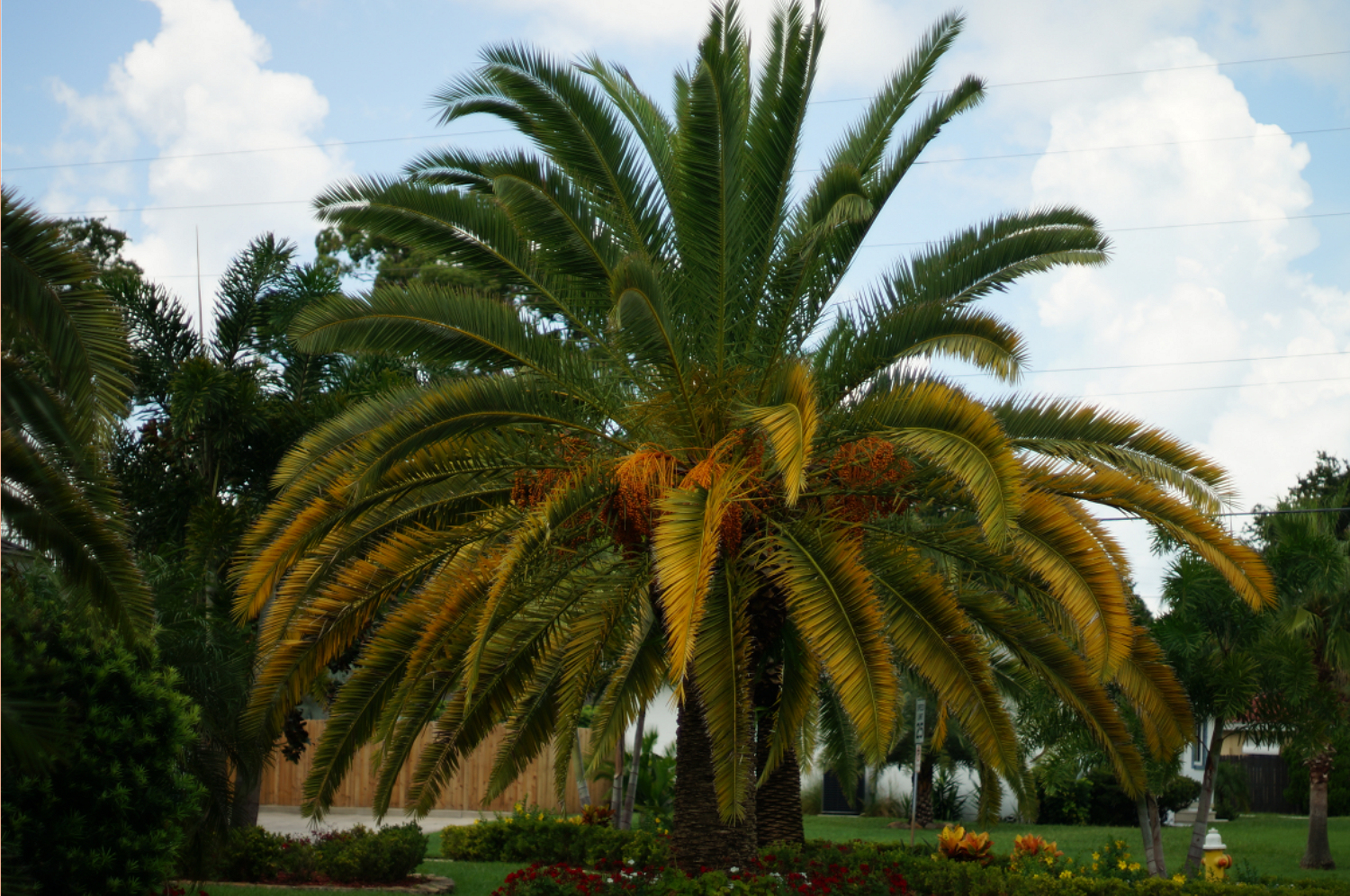MANGANESE DEFICIENCY (FRIZZLE TOP):

Manganese (Mn) deficiency is most common in queen, royal and roebelenii palms, though it can occur in many other palms. It manifests itself as deformed growth on the emerging fronds. The new growth will appear stunted, crinkled and curled at the tips. Mn deficiencies are more common in the western part of the county, but can show up anywhere. If left untreated, the palm will eventually die. If caught soon enough, a Mn deficiency can be corrected. Once the palm has recovered, our semi-annual maintenance program will assure that the palm does not regress and become deficient again.
MAGNESIUM (MG) DEFICIENCY:

Magnesium (Mg) deficiency is common in many palms and sometimes shows up along with Mn deficiency (frizzle top). Mg deficiency is not as serious a problem as Mn deficiency, though it still should not be left untreated. Mg deficiency appears as a premature yellowing of the fronds, especially the new fronds. It is normal in some palms to have the lower growth to discolor slightly. This is a sign that the palms need to be trimmed.
GANODERMA BUTT ROT:

Ganoderma butt rot is caused by the fungus Ganoderma zonatum. This organism causes a gradual decline in palms. Unfortunately, there is no cure for Ganoderma. It is most commonly a result of an injury to the trunk of the palm. After a palm is injured, the Ganoderma fungus gets inside the palm and slowly kills the palm. A palm affected with Ganoderma will slowly decline over a period of time. The fronds will be droopy and will eventually hang limp. Eventually, usually two to three years after infection, an orange or white mushroom-like growth will appear usually at the base of the palm. Ganoderma can occur in any palm, but it is mostly seen on areca and queen palms.
ROYAL PALM BUG:

Royal palm bug is an insect that feeds exclusively on royal palms. These insects feed on newly emerged fronds and cause the fronds to have an unsightly, tattered appearance. Royal palm bug is not usually fatal, but it can make beautiful royal palms appear quite unattractive. Palm Tree Doctor has a very effective treatment for this problem.
LIGHTNING STRIKES:

Lightning strikes are very common in South Florida, especially in the summer months. Most palms that are struck by lightning will eventually die. If the lightning strike does not kill the palm right away, the palm will retain a green spear and might have a chance for recovery. Palm Tree Doctor has a very effective treatment to help the palm cope with the stress from a lighting strike. It is important that the palm is treated very soon after the strike to increase chances of survival.
IMPROPER PRUNING:

It is important to have your palms trimmed properly. Over-pruning or improper pruning can induce nutrient deficiencies on healthy palms and can actually kill palms that are not healthy. Palms store nutrition and energy in their healthy fronds and removing too many fronds steals nutrition that the palm is expecting to utilize. Never remove more than 15% of the canopy of a healthy palm and never remove fronds from a palm that is not healthy unless the frond is 100% brown. In addition, never remove fronds from the middle of the canopy leaving only lower fronds.
 Manganese (Mn) deficiency is most common in queen, royal and roebelenii palms, though it can occur in many other palms. It manifests itself as deformed growth on the emerging fronds. The new growth will appear stunted, crinkled and curled at the tips. Mn deficiencies are more common in the western part of the county, but can show up anywhere. If left untreated, the palm will eventually die. If caught soon enough, a Mn deficiency can be corrected. Once the palm has recovered, our semi-annual maintenance program will assure that the palm does not regress and become deficient again.
Manganese (Mn) deficiency is most common in queen, royal and roebelenii palms, though it can occur in many other palms. It manifests itself as deformed growth on the emerging fronds. The new growth will appear stunted, crinkled and curled at the tips. Mn deficiencies are more common in the western part of the county, but can show up anywhere. If left untreated, the palm will eventually die. If caught soon enough, a Mn deficiency can be corrected. Once the palm has recovered, our semi-annual maintenance program will assure that the palm does not regress and become deficient again.
 Magnesium (Mg) deficiency is common in many palms and sometimes shows up along with Mn deficiency (frizzle top). Mg deficiency is not as serious a problem as Mn deficiency, though it still should not be left untreated. Mg deficiency appears as a premature yellowing of the fronds, especially the new fronds. It is normal in some palms to have the lower growth to discolor slightly. This is a sign that the palms need to be trimmed.
Magnesium (Mg) deficiency is common in many palms and sometimes shows up along with Mn deficiency (frizzle top). Mg deficiency is not as serious a problem as Mn deficiency, though it still should not be left untreated. Mg deficiency appears as a premature yellowing of the fronds, especially the new fronds. It is normal in some palms to have the lower growth to discolor slightly. This is a sign that the palms need to be trimmed.
 Ganoderma butt rot is caused by the fungus Ganoderma zonatum. This organism causes a gradual decline in palms. Unfortunately, there is no cure for Ganoderma. It is most commonly a result of an injury to the trunk of the palm. After a palm is injured, the Ganoderma fungus gets inside the palm and slowly kills the palm. A palm affected with Ganoderma will slowly decline over a period of time. The fronds will be droopy and will eventually hang limp. Eventually, usually two to three years after infection, an orange or white mushroom-like growth will appear usually at the base of the palm. Ganoderma can occur in any palm, but it is mostly seen on areca and queen palms.
Ganoderma butt rot is caused by the fungus Ganoderma zonatum. This organism causes a gradual decline in palms. Unfortunately, there is no cure for Ganoderma. It is most commonly a result of an injury to the trunk of the palm. After a palm is injured, the Ganoderma fungus gets inside the palm and slowly kills the palm. A palm affected with Ganoderma will slowly decline over a period of time. The fronds will be droopy and will eventually hang limp. Eventually, usually two to three years after infection, an orange or white mushroom-like growth will appear usually at the base of the palm. Ganoderma can occur in any palm, but it is mostly seen on areca and queen palms.
 Royal palm bug is an insect that feeds exclusively on royal palms. These insects feed on newly emerged fronds and cause the fronds to have an unsightly, tattered appearance. Royal palm bug is not usually fatal, but it can make beautiful royal palms appear quite unattractive. Palm Tree Doctor has a very effective treatment for this problem.
Royal palm bug is an insect that feeds exclusively on royal palms. These insects feed on newly emerged fronds and cause the fronds to have an unsightly, tattered appearance. Royal palm bug is not usually fatal, but it can make beautiful royal palms appear quite unattractive. Palm Tree Doctor has a very effective treatment for this problem.
 Lightning strikes are very common in South Florida, especially in the summer months. Most palms that are struck by lightning will eventually die. If the lightning strike does not kill the palm right away, the palm will retain a green spear and might have a chance for recovery. Palm Tree Doctor has a very effective treatment to help the palm cope with the stress from a lighting strike. It is important that the palm is treated very soon after the strike to increase chances of survival.
Lightning strikes are very common in South Florida, especially in the summer months. Most palms that are struck by lightning will eventually die. If the lightning strike does not kill the palm right away, the palm will retain a green spear and might have a chance for recovery. Palm Tree Doctor has a very effective treatment to help the palm cope with the stress from a lighting strike. It is important that the palm is treated very soon after the strike to increase chances of survival.
 It is important to have your palms trimmed properly. Over-pruning or improper pruning can induce nutrient deficiencies on healthy palms and can actually kill palms that are not healthy. Palms store nutrition and energy in their healthy fronds and removing too many fronds steals nutrition that the palm is expecting to utilize. Never remove more than 15% of the canopy of a healthy palm and never remove fronds from a palm that is not healthy unless the frond is 100% brown. In addition, never remove fronds from the middle of the canopy leaving only lower fronds.
It is important to have your palms trimmed properly. Over-pruning or improper pruning can induce nutrient deficiencies on healthy palms and can actually kill palms that are not healthy. Palms store nutrition and energy in their healthy fronds and removing too many fronds steals nutrition that the palm is expecting to utilize. Never remove more than 15% of the canopy of a healthy palm and never remove fronds from a palm that is not healthy unless the frond is 100% brown. In addition, never remove fronds from the middle of the canopy leaving only lower fronds.

